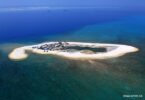The present government seems keen to give preference to the execution of clean and expensive energy projects over the environment polluting thermal power projects of which the last PML-N government was fond of. Categorically telling the Chinese friends to delete the 1320 MW coal fired power project from the CPEC list is a bold indication of right priorities. After the completion of Tarbella Dam of President Ayub Khan Era of1960s, planning and launching of hydropower generation remained the proverbial prohibited tree in civilian governments, inflicting a colossal loss of billions of dollars annually to the economy. Decision of the PML-N previous government to set up 13coal based power plants of Chinese crude, unreliable and short life span technology at exorbitant construction cost and highly inflated per unit power tariff is classic example of skewed priorities.
A state-run Russian firm, Inter RAO Engineering has offered to invest $ 2 billion in Pakistan’s water and power sector including Mohammand dam. If the Russian firm investment offer materializes it will ensure timely execution of a number of hydropower projects enhancing the percentage of inexpensive electricity in the total power mix. Inter RAO Engineering is one of the largest Russian public sector energy companies that has joint ventures with West European companies like Siemens. It will help induct state-of-the-art technology in power generation, transmission and distribution systems.
The beneficial aspect of Russian cooperation is that its energy firm wants a deal on government to government basis which will save the country and its people from the energy traps like IPPs and Chinese private power producing companies which are the major causes of power sector circular debt. It will also ensure completion of hydropower project minimizing the probability massive cost escalations.
The representatives of Russian firm had held meeting with high officials of Water and Power Development Authority (WAPDA) and Federal Minister for water and power Omer Ayub Khan in November last year. They have suggested to Pakistani authorities to club five small hydropower projects. The willingness of Russian firm to provide finances for Mohamand dam can provide an opportunity for attracting investment in Diyamer Basha dam. The multilateral donors including the World Bank and Asian Development Bank have shied away from this project. The firm is ready to invest in some key water and power projects, including 7,100 MW Buji, 52 MW Naseri, 2500 MW Yubloo, 2,200 MW Tangus and 800 MW Mohamand. It is also willing to provide technical support and financing for these projects which cost 318 billion.
The Indus River System has an identified hydropower potential of 60,185 MW, out of which around 9,404 MW is exploited, which is 15.6 percent of the total identified potential. The Indus River alone has an identified hydropower potential of 39,558 MW. The tributaries of this river in Gilgit Baltistan have a hydropower potential of 1,698 MW and its tributaries in Khyber Pukhtunkhwa have the potential of 4,028 MW.
The Jhelum River has an identified hydropower potential of 4,341 MW, the Kunar River 1,454, Neelum River and its tributaries 1,769 and Poonch 462 MW. The Swat River and its tributaries have an identified hydropower potential of 22, 297 and the Chitral River and its tributaries have the potential of 2, 2 8 MW. Had the elected governments since 1972 given preference to inexpensive hydel power generation over expensive and environment polluting thermal power along with upgrading the transmission and distribution systems, both agriculture and manufacturing sector would have boomed, bringing prosperity to the country and its people. It is the shy high tariff of energy inputs that have bombed these sectors putting the people in the vicious circle of poverty. But ironically, the door on hydropower generation was slammed deliberately by making it the proverbial prohibited fruit by the ruling feudal and mercantile classes. Hopefully, PTI government will give top priority to construction of storage dams and hydel power stations thereon.






